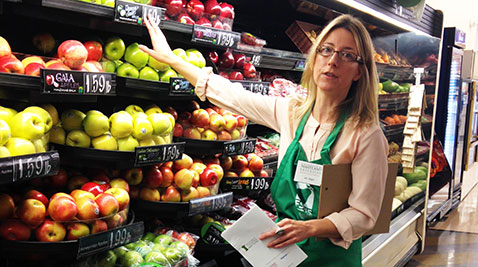GAITHERSBURG- Lillian Robins is marinating chicken breasts in dried spices and olive oil in her fridge for dinner on Friday, and pork chops in a similar marinade for the weekend. She is also freezing blueberries to add to her morning oatmeal, or to blend with frozen bananas for a refreshing smoothie.
Robins, 56, isn’t your average health-conscious eater. She has received food stamps for nearly two years, and is one of 47 million Americans trying to make the most of their food dollars before benefits are cut from the Supplement Nutrition Assistance Program, or SNAP, on Friday.
“It’s expensive to eat healthy,” said Robins, who lives in Chevy Chase with her 21-year-old daughter. “Right now we aren’t eating as healthy as we should be but we’re eating as much healthy food as we can afford.”

Robins is one of 787,382 Maryland families dependent on food stamps that will lose a portion of their benefits beginning Friday. This is due to the expiration of part of the 2009 American Recovery and Reinvestment Act, better known as the stimulus, which increased benefits for SNAP households during the worst of the recession.
Rep. Andy Harris, R-Cockeysville, said cuts in the program — which has doubled over the last three years — would help eliminate fraud.
“We want to get the food stamps in the hands of the people who deserve it,” he told CNN last month.
Families of two, like Robins’, will lose up to $20 a month because of the cuts. Families of three and four will lose up to $29 and $36 respectively, while a single household will lose $11, according to the U.S. Department of Agriculture.
On average, these cuts amount to 21 meals per month for a family of four, or 16 meals for a family of three, according to the Center for Budget and Policy Priorities, a Washington-based think tank. The cuts worry Maryland food stamp recipients, and the organizations that support them.
Lynn Rubin, program development and outreach coordinator for food supplement nutrition education at the University of Maryland Extension, said that it is important to educate SNAP recipients on the cuts and provide them with options to put food on the table.
“It was crucial before and even more crucial now,” she said. “You’re being forced to do more with less, and people need to learn strategies to reach dietary guidelines on a food budget.”

Rubin and her partner organizations are running classes and grocery store tours to educate low-income families. The University of Maryland Extension partnered with Share Our Strength’s No Kid Hungry, which provides interactive grocery store tours designed to help low-income families make the most of food resources and cook healthy meals at home.
A recent study by Share Our Strength showed that most families — eight in 10 — make dinner from scratch at home at least five times a week. The online study, conducted by APCO Insight, primarily surveyed low to middle income families in the United States and included supplemental telephone interviews.
“We’re really trying to make sure these families know of the resources available to them because making food at home is the most cost effective way,” said Alexandra Smith, Maryland outreach manager for the Share Our Strength’s No Kid Hungry program, Cooking Matters at the Store. “These [SNAP] cuts are going to be real, and providing a nutritious education could actually make an impact on family.”
Robins, who attended Cooking Matters at the Store at a Giant in Rockville on Tuesday, described the tour as a beneficial learning experience.
“I never used to look at the red sticker with the unit price or look at the ingredient list of what I’m buying,” Robins said. “I also learned that frozen vegetables are just as healthy as fresh ones because they have the same nutrients, and they’re cheaper.”
The Maryland Department of Human Resources and the Maryland Food Bank have been sending out information packets to recipients to help prepare them for the upcoming cuts. Similarly, USDA has provided online resources on budgeting and shopping strategies, meal planning ideas and nutrition advice for consumers.

Food stamp recipients aren’t going to be the only ones affected by the cuts. The Maryland Food Bank — already struggling to meet the increased need for food as a result of the recent government shutdown — is worried the cuts will force more recipients to rely entirely on their network.
“As fast as food comes into our doors, it’s back out,” said Kate Sam, director of communications at the Maryland Food Bank.
Maryland will lose a projected $82 million because of the food stamp cuts, which could hurt the economy. Every dollar in SNAP benefits creates at least about $1.70 in economic activity, according to CBPP.
Rubin said she was worried that further cuts could be made to the food stamp program in the future. Going forward, she said, it will be more important for people like Robins to know how to stretch their limited food dollars.
“I’ve always been a thrifty shopper buying my food,” Robins said. “I just have to get more [food] from food banks or my church and to be a thriftier shopper than I was before.”


You must be logged in to post a comment.